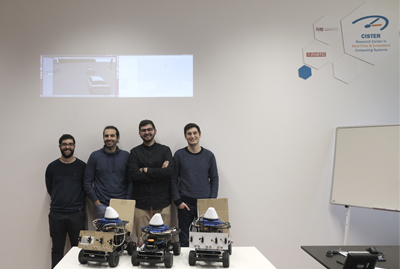 The research effort carried out in the SafeCOP project, resulted in several relevant and innovative tools, that can effectively support multiple research and development activities in the topics of connected and autonomous vehicles. First, the COPADRIVe simulator, consists of a co-simulation framework for cooperative autonomous vehicles, pairing a well-known robotics simulator i.e., Gazebo with a network simulator i.e., OMNeT++. Glued by the ROS middleware, and relying on its ecosystem, this tool is able to support a realistic simulation of a vehicle's dynamics, its control and perception, while simulating in parallel the underlying networking aspects, using an ETSI ITS-G5 communications stack. The resulting framework supports the analysis of the network impact upon the vehicular control aspects and vice-versa, enabling a profound analysis of such cooperative cyber-physical systems in its different dimensions: physical dynamics, control, and networking.The development team quickly realized that such a powerful simulation tool, could be potentially extended to encompass Hardware-in-the-Loop (HiL) capabilities, aiming at testing real-life components, in an integrated fashion with the Robotics simulation. One interesting use-case example, explored in the SafeCOP project together with the company GMV Skysoft, consisted in testing additional wireless safety components embedded in the communications’ On Board Units (OBUs), to enable a control loss warning (CLW) safety application in vehicular platooning systems.
The research effort carried out in the SafeCOP project, resulted in several relevant and innovative tools, that can effectively support multiple research and development activities in the topics of connected and autonomous vehicles. First, the COPADRIVe simulator, consists of a co-simulation framework for cooperative autonomous vehicles, pairing a well-known robotics simulator i.e., Gazebo with a network simulator i.e., OMNeT++. Glued by the ROS middleware, and relying on its ecosystem, this tool is able to support a realistic simulation of a vehicle's dynamics, its control and perception, while simulating in parallel the underlying networking aspects, using an ETSI ITS-G5 communications stack. The resulting framework supports the analysis of the network impact upon the vehicular control aspects and vice-versa, enabling a profound analysis of such cooperative cyber-physical systems in its different dimensions: physical dynamics, control, and networking.The development team quickly realized that such a powerful simulation tool, could be potentially extended to encompass Hardware-in-the-Loop (HiL) capabilities, aiming at testing real-life components, in an integrated fashion with the Robotics simulation. One interesting use-case example, explored in the SafeCOP project together with the company GMV Skysoft, consisted in testing additional wireless safety components embedded in the communications’ On Board Units (OBUs), to enable a control loss warning (CLW) safety application in vehicular platooning systems.
Finally, to get away from the computer screen into more realistic settings, the team developed a completely autonomous 1/10th scale robotic platooning testbed with three vehicles. This testbed, inspired by the F1/10 competition architecture, powered by proven and powerful processing hardware and sensors, i.e. Nvidia Jetson TX2, ZED cameras, and LIDARs, is able to support the validation and demonstration of different platooning and autonomous driving algorithms, using different perception and control techniques. Again, previous results from the evaluation of the CLW application were successfully validated and demonstrated in this robotic testbed, proving that such safety mechanisms could effectively contribute to a significant safety increase in such cooperating vehicular systems.
Importantly, these research and development activities, also triggered three academic successes. Recently, the three MSc. students which composed this team led by Ricardo Severino, successfully defended their Thesis at ISEP. Daniel Almeida and Nuno Guedes, in charge of the development of the autonomous vehicle and of the platooning robotic testbed respectively, were graded 18 out of 20. Still working on a research paper related to their platooning testbed solution, these students have carried out a tremendous amount of work, integrating a multitude of software and hardware components, perception, planning and control algorithms to make this testbed a reality. Finally, Bruno Vieira, in charge of the simulation toolset, namely the COPADRIVe co-simulation framework, also defended his Thesis, achieving the excellent grade of 19 out of 20. Bruno will continue his research career with us towards his PhD.
To disseminate the toolset, CISTER also organized two seminars integrated in the CISTER Periodic Seminar series, which the reader can still access at:
Autonomous Driving and Platooning Robotic Testbed
A Simulation Approach for Increased Safety in Advanced C-ITS Scenarios

